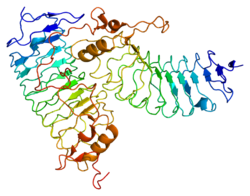Glykoprotein Ib
aus Wikipedia, der freien Enzyklopädie
| Glykoprotein Ib | ||
|---|---|---|

| ||
| nach PDB 1GWB | ||
| Andere Namen |
Antigen CD42b, CD42b, Platelet glycoprotein Ib | |
| Eigenschaften des menschlichen Proteins | ||
| Masse/Länge Primärstruktur | 652 Aminosäuren + 206 Aminosäuren, 21.718 Da + 71.540 Da | |
| Sekundär- bis Quartärstruktur | Heterodimer | |
| Bezeichner | ||
| Externe IDs | ||
| Orthologe (Mensch) | ||
| Entrez | 953 | |
| Ensembl | ENSG00000138185 | |
| UniProt | P07359 | |
| Refseq (mRNA) | NM_001098175.1 | |
| Refseq (Protein) | NP_001091645.1 | |
| PubMed-Suche | 953
| |
Glykoprotein Ib (synonym CD42, GP-Ib) ist ein Oberflächenprotein auf Thrombozyten.
Eigenschaften
GP Ib ist an der Blutgerinnung beteiligt. Es bindet an die A1-Domäne des Von-Willebrand-Faktors. Lateral bindet es Faktor IX, intrazellulär an ABP-280.[1] Es ist glykosyliert, phosphoryliert und sulfatiert. Eine Mutation des GP Ib ist verantwortlich für das Bernard-Soulier-Syndrom.[2] Eine Gain-of-Function-Mutation erzeugt den Thrombozyten-Typ der Von-Willebrand-Krankheit.[3]
Weblinks
Einzelnachweise
- ↑ D. Shang, Z. Zhang, Q. Wang, Y. Ran, T. S. Shaw, J. N. Van, Y. Peng: Membrane skeleton orchestrates the platelet glycoprotein (GP) Ib-IX complex clustering and signaling. In: IUBMB life. Band 68, Nummer 10, Oktober 2016, S. 823–829, doi:10.1002/iub.1559, PMID 27634617.
- ↑ L. M. Xu, G. B. Sun, P. Wang, N. Sun, Q. P. Hu, F. F. Cao, B. Peng, D. H. Zhang: Single novel mutation in transmembrane region of glycoprotein (GP) IX affects GP Ib-IX complex expression and causes Bernard-Soulier syndrome. In: British Journal of Haematology. Band 150, Nummer 5, September 2010, S. 627–629, doi:10.1111/j.1365-2141.2010.08241.x, PMID 20497174.
- ↑ McPherson & Pincus: Henry's Clinical Diagnosis and Management by Laboratory Methods, 21. Ausgabe, S. 760-2 (W.B. Saunders, 2006).